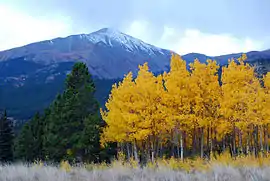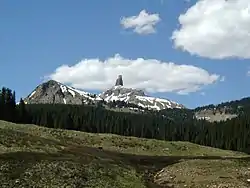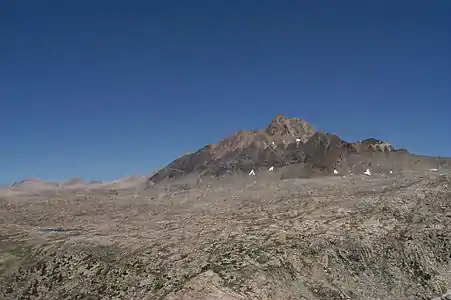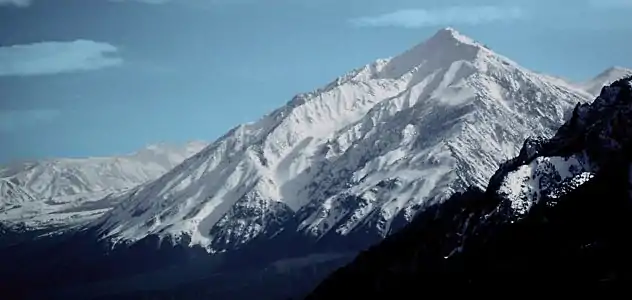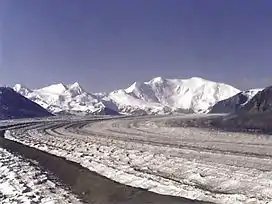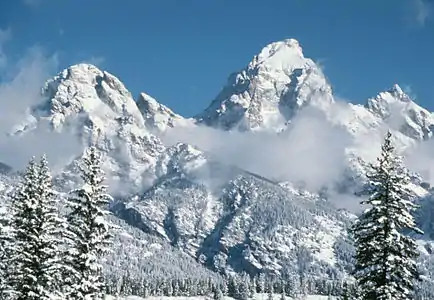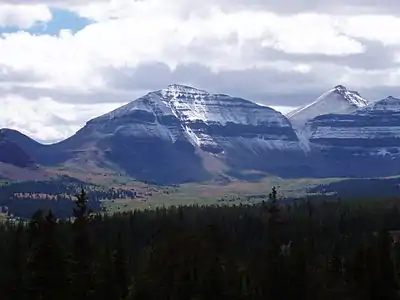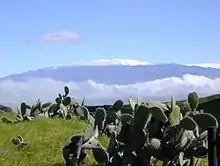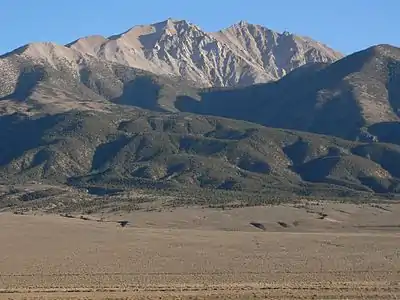Thirteener
In mountaineering in the United States, a thirteener (abbreviated 13er) is a mountain that exceeds 13,000 feet (3,962.4 m) above mean sea level, similar to the more familiar "fourteeners," which exceed 14,000 feet (4,267.2 m). In most instances, "thirteeners" refers only to those peaks between 13,000 and 13,999 feet in elevation.
The importance of thirteeners is greatest in Colorado, which has the majority of such peaks in North America with over 600 of them. Despite the large number of peaks, over 20 peak baggers have reported climbing all of Colorado's thirteeners.[1] Thirteeners are also significant in states whose highpoints fall between 13,000 and 13,999 feet. For example, the Wyoming thirteeners are the highest peaks within the state, and only 5 individuals have reported climbing all 35 peaks, likely due to a combination of technical difficulty and remoteness.[2][3]
Not all summits over 13,000 feet qualify as thirteeners, but only those summits that mountaineers consider to be independent. Objective standards for independence include topographic prominence and isolation (distance from a higher summit), or a combination. However thirteener lists do not always consistently use such objective rules. A rule commonly used by mountaineers in the contiguous United States is that a peak must have at least 300 feet (91 m) of prominence to qualify. According to the Mountaineering Club of Alaska, it is standard in Alaska to use a 500 ft (152 m) prominence rule rather than a 300-foot rule. These are the standards applied for the lists below. Regarding whether or not peaks in excess of 13,999 feet should be considered as "thirteeners", this article will count them as such for statistical purposes, but concentrate its focus on those peaks less than 14,000 feet since the higher peaks are already covered in the fourteeners list.
List of United States thirteeners by state
Thirteeners are found in nine U.S. states. This table summarizes their numbers based on each state's prominence criteria:
| U.S. State | Thirteeners | Fourteeners | Highest 13er < 14,000 ft | Elevation |
|---|---|---|---|---|
| Colorado | 637 | 53 | Grizzly Peak | 13,988 ft (4,264 m) |
| California | 149 | 12 | Mount Barnard | 13,990 ft (4,264 m) |
| Alaska | 41 | 20 | Mount Hunter, South Peak | 13,966 ft (4,257 m) |
| Wyoming | 35 | 0 | Gannett Peak | 13,804 ft (4,207 m) |
| Utah | 17 | 0 | Kings Peak | 13,528 ft (4,123 m) |
| New Mexico | 3 | 0 | Wheeler Peak | 13,161 ft (4,011 m) |
| Hawaii | 2 | 0 | Mauna Kea | 13,796 ft (4,205 m) |
| Nevada | 2 | 0 | Boundary Peak | 13,140 ft (4,005 m) |
| Washington | 0 | 1 | none | - |
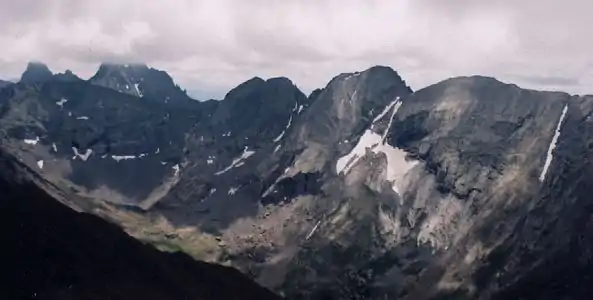
Colorado
By the most detailed count, Colorado has 637 peaks that exceed 13,000 feet (4,000 m) and meet the prominence criteria, of which 53 are fourteeners.[4][5] The highest of them less than 14,000 feet are as follows (the rank includes higher peaks):
| Rank | Mountain | Elevation | Range |
|---|---|---|---|
| 54 | Grizzly Peak | 13,988 ft (4,264 m) | Sawatch Range |
| 55 | Stewart Peak | 13,983 ft (4,262 m) | San Juan Mountains |
| 56 | Columbia Point | 13,980 ft (4,261 m) | Sangre de Cristo Range |
| 57 | Pigeon Peak | 13,972 ft (4,259 m) | San Juan Mountains |
| 58 | Mount Ouray | 13,971 ft (4,258 m) | Sawatch Range |
| 59 | Ice Mountain | 13,951 ft (4,252 m) | Sawatch Range |
| 60 | Fletcher Mountain | 13,951 ft (4,252 m) | Tenmile Range |
| 61 | Pacific Peak | 13,950 ft (4,252 m) | Tenmile Range |
Grizzly Peak is not only the name of Colorado's highest thirteener, but the state has four other Grizzly Peaks plus one Grizzly Mountain on the list:
| Rank | Mountain | Elevation | Range |
|---|---|---|---|
| 130 | Grizzly Peak | 13,738 ft (4,187 m) | San Juan Mountains |
| 142 | Grizzly Mountain | 13,708 ft (4,178 m) | Sawatch Range |
| 145 | Grizzly Peak | 13,700 ft (4,176 m) | San Juan Mountains |
| 302 | Grizzly Peak | 13,427 ft (4,093 m) | Front Range |
| 415 | Grizzly Peak | 13,281 ft (4,048 m) | Sawatch Range |
Other notable Colorado thirteeners include:
| Rank | Mountain | Elevation | Range |
|---|---|---|---|
| 66 | Mount Adams | 13,931 ft (4,246 m) | Sangre de Cristo Range |
| 68 | Mount Meeker | 13,911 ft (4,240 m) | Front Range |
| 82 | Crystal Peak | 13,852 ft (4,222 m) | Tenmile Range |
| 89 | Turret Peak | 13,835 ft (4,217 m) | Needle Mountains |
| 96 | Mount Silverheels | 13,822 ft (4,213 m) | Mosquito Range |
| 131 | Argentine Peak | 13,738 ft (4,187 m) | Tenmile Range |
| 253 | North Arapaho Peak | 13,502 ft (4,115 m) | Front Range |
| 304 | Mummy Mountain | 13,425 ft (4,092 m) | Mummy Range |
| 324 | Parry Peak | 13,391 ft (4,082 m) | Front Range |
| 451 | Hesperus Mountain | 13,232 ft (4,033 m) | San Juan Mountains |
| 515 | Twilight Peak | 13,158 ft (4,011 m) | San Juan Mountains |
| 556 | Lizard Head | 13,113 ft (3,997 m) | San Juan Mountains |
California
California has the second greatest number of thirteeners with 149[6] of them, of which 12 are fourteeners. The highest under 14,000 feet are as follows (the rank includes higher peaks):
| Rank | Mountain | Elevation | Range |
|---|---|---|---|
| 13 | Mount Barnard | 13,990 ft (4,264 m) | Sierra Nevada |
| 14 | Mount Humphreys | 13,986 ft (4,263 m) | Sierra Nevada |
| 15 | Mount Keith | 13,975 ft (4,260 m) | Sierra Nevada |
| 16 | Mount Stanford | 13,973 ft (4,259 m) | Sierra Nevada |
Other notable California thirteeners include:
Alaska
Alaska has at least 41 thirteeners that meet its more stringent prominence criteria of 500 ft, of which 20 are also fourteeners. Different sources list varying numbers of 13,000+ ft peaks in the state,[7][8][9] mainly because many of the peaks (especially those that are sub-peaks of a higher mountain) are unnamed and have no spot elevations given on the USGS topographical maps. Using a 300' interpolated prominence criterion, there are 61 13,000+ ft peaks in Alaska.[10] The following list may miss a few peaks that should be included:
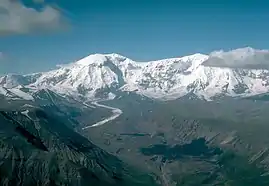
| Rank | Mountain | Elevation | Range |
|---|---|---|---|
| 21 | Mount Hunter, South Peak | 13,966 ft (4,257 m) | Alaska Range |
| 22 | Atna Peaks | 13,860 ft (4,225 m) | Wrangell Mountains |
| 23 | Regal Mountain | 13,845 ft (4,220 m) | Wrangell Mountains |
| 24 | Mount Hayes | 13,832 ft (4,216 m) | Alaska Range |
| 25 | Mount Cook | 13,760 ft (4,194 m) | Saint Elias Mountains |
| 26 | Mount Sanford, South Peak | 13,654 ft (4,162 m) | Wrangell Mountains |
| 27 | Mount Quincy Adams | 13,615 ft (4,150 m) | Fairweather Range |
| 28 | Ocypete Peak | 13,550 ft (4,130 m) | Saint Elias Mountains |
| 29 | East Kahiltna Peak | 13,440 ft (4,097 m) | Alaska Range |
| 30 | Mount Natazhat | 13,435 ft (4,095 m) | Saint Elias Mountains |
| 31 | Mount Jarvis | 13,421 ft (4,091 m) | Wrangell Mountains |
| 32 | Mount Hunter, Middle Peak | 13,400 ft (4,084 m) + | Alaska Range |
| 33 | Mount Bona, East Peak (Tressider Peak) | 13,315 ft (4,058 m) | Saint Elias Mountains |
| 34 | Mount Hayes, South Peak | 13,305 ft (4,055 m) | Alaska Range |
| 35 | Celeno Peak | 13,300 ft (4,054 m) + | Saint Elias Mountains |
| 36 | Parka Peak | 13,280 ft (4,048 m) | Wrangell Mountains |
| 37 | Mount Silverthrone | 13,220 ft (4,029 m) | Alaska Range |
| 38 | Mount Marcus Baker | 13,176 ft (4,016 m) | Chugach Mountains |
| 39 | Mount Jarvis, North Peak | 13,025 ft (3,970 m) | Wrangell Mountains |
| 40 | Mount Moffit | 13,020 ft (3,968 m) | Alaska Range |
| 41 | Mount Zanetti | 13,009 ft (3,965 m) | Wrangell Mountains |
Wyoming
Wyoming has 35 thirteeners with at least 300 ft of interpolated prominence, but no fourteeners.[11] 31 of the 35 are located in the rugged and remote Wind River Range. Several of the Wyoming thirteeners require glacier travel and/or rock climbing up to the 5.4 YDS difficulty level to reach the summit, and most climbers spend multiple days backpacking to reach most of these peaks.[12] The highest of them are:
| Rank | Mountain | Elevation | Range |
|---|---|---|---|
| 1 | Gannett Peak | 13,804 ft (4,207 m) | Wind River Range |
| 2 | Grand Teton | 13,770 ft (4,197 m) | Teton Range |
| 3 | Fremont Peak | 13,745 ft (4,189 m) | Wind River Range |
| 4 | Mount Warren | 13,722 ft (4,182 m) | Wind River Range |
| 5 | Mount Helen | 13,620 ft (4,151 m) | Wind River Range |
| 6 | Turret Peak | 13,620 ft (4,151 m) | Wind River Range |
| 7 | Mount Sacagawea | 13,569 ft (4,136 m) | Wind River Range |
| 8 | Jackson Peak | 13,517 ft (4,120 m) | Wind River Range |
| 9 | Mount Woodrow Wilson | 13,502 ft (4,115 m) | Wind River Range |
| 10 | Bastion Peak | 13,494 ft (4,113 m) | Wind River Range |
| 11 | Mount Febbas | 13,468 ft (4,105 m) | Wind River Range |
| 12 | Flagstone Peak | 13,450 ft (4,100 m) | Wind River Range |
| 13 | Sunbeam Peak | 13,440 ft (4,097 m) | Wind River Range |
| 14 | Pinnacle Ridge | 13,365 ft (4,074 m) | Wind River Range |
| 15 | Downs Mountain | 13,349 ft (4,069 m) | Wind River Range |
Other notable Wyoming thirteeners include:
| Rank | Mountain | Elevation | Range |
|---|---|---|---|
| 20 | Wind River Peak | 13,192 ft (4,021 m) | Wind River Range |
| 23 | Cloud Peak | 13,167 ft (4,013 m) | Big Horn Mountains |
| 26 | Francs Peak | 13,153 ft (4,009 m) | Absaroka Range |
| 33 | Black Tooth Mountain | 13,005 ft (3,964 m) | Big Horn Mountains |
Utah
Utah has 17 thirteeners with at least 300 ft of prominence, but no fourteeners.[13][14] All of them are located in the remote Uinta Mountains near the Wyoming border. The highest of the thirteeners are:
| Rank | Mountain | Elevation | Range |
|---|---|---|---|
| 1 | Kings Peak | 13,528 ft (4,123 m) | Uinta Mountains |
| 2 | South Kings Peak | 13,512 ft (4,118 m) | Uinta Mountains |
| 3 | Gilbert Peak | 13,442 ft (4,097 m) | Uinta Mountains |
| 4 | Mount Emmons | 13,440 ft (4,097 m) | Uinta Mountains |
New Mexico
New Mexico has 3 thirteeners, all located within about 40 miles (64 km) of each other in the Sangre de Cristo Mountains.[15]
| Rank | Mountain | Elevation | Range |
|---|---|---|---|
| 1 | Wheeler Peak | 13,161 ft (4,011 m) | Sangre de Cristo Mountains |
| 2 | Truchas Peak | 13,102 ft (3,993 m) | Sangre de Cristo Mountains |
| 3 | North Truchas Peak | 13,024 ft (3,970 m) | Sangre de Cristo Mountains |
Hawaii
Hawaii has two thirteeners,[16] the great shield volcanoes which comprise the bulk of the Big Island of Hawaii.
| Rank | Mountain | Elevation | Range |
|---|---|---|---|
| 1 | Mauna Kea | 13,796 ft (4,205 m) | Island of Hawaii |
| 2 | Mauna Loa | 13,680 ft (4,170 m) | Island of Hawaii |
Nevada
Nevada has only a single thirteener that meets the threshold for inclusion, Wheeler Peak in Great Basin National Park with an impressive 7,568 feet (2,307 m) of prominence. However, the highest point in the state is Boundary Peak, which is a sub-peak of California's Montgomery Peak with only 240 feet (73 m) of prominence.[17]
| Mountain | Elevation | Range |
|---|---|---|
| Boundary Peak | 13,140 ft (4,005 m) | White Mountains |
| Wheeler Peak | 13,065 ft (3,982 m) | Snake Range |
Washington
Mount Rainier is the only mountain in Washington state that exceeds 13,000 feet (4,000 m), and it has two summits that meet the prominence criteria,[18] both of which are included on the list of fourteeners.
See also
- Outline of the United States
- Index of United States-related articles
- Fourteener
- Mountain peaks of Alaska
- Mountain peaks of California
- Mountain peaks of Colorado
- Mountain peaks of the Rocky Mountains
- Mountain peaks of the United States
References
- "Colorado 13ers List". listsofjohn.com. Retrieved 2016-10-06.
- "Climbing the Wyoming 13ers • Sunlit Summit". Sunlit Summit. Retrieved 2020-11-13.
- "13ers of Wyoming". listsofjohn.com. Retrieved 2020-11-13.
- Roach, Gerry; Roach, Jennifer (2001). Colorado's Thirteeners, 13,800 to 13,999 Feet: From Hikes to Climbs. Fulcrum Publishing. ISBN 1-55591-419-5.
- "Colorado's Summits – 13,000 to 13,999 feet". Retrieved 2007-03-02.
- "California Thirteeners". Retrieved 2009-03-09.
- "Alaska's Summits 13,000 feet and above". Retrieved 2007-03-02.
- "Alaska 13,000-foot Peaks". Retrieved 2007-03-02.
- "Highest Alaskan Summits (Wrangell-St. Elias National Park & Preserve)" (PDF). Retrieved 2007-03-11.
- "Alaska's Highest Peaks". Retrieved 2016-03-02.
- "WY 13er Peak Profiles". listsofjohn.com. Retrieved 2020-11-13.
- "Climbing the Wyoming 13ers • Sunlit Summit". Sunlit Summit. Retrieved 2020-11-13.
- Rose, David (2004). Utah Thirteeners. University of Utah Press. ISBN 0-87480-794-8.
- "Utah's Summits over 13,000 feet". Retrieved 2007-03-02.
- "New Mexico's Summits over 12,000 feet". Retrieved 2007-03-02.
- "Hawaii's Summits over 13,000 feet". Retrieved 2007-03-02.
- "Nevada's Summits over 13,000 feet". Retrieved 2007-03-02.
- "Washington's Summits over 13,000 feet". Archived from the original on 2009-12-24. Retrieved 2007-03-02.
External links
- listsofjohn.com (Full listing of US 13ers excluding Alaska)
- Peak Lists by Gerry Roach (Lists of thirteeners in several states)
- 13ers.com - Home of Colorado's Thirteeners (Mountains Between 13,000 and 14,000 feet)
- Climb13ers.com - Peakbagging Info (including routes, maps & photos) for Colorado 13ers
- SunlitSummit.com - Photos and Trip Report for all of the Wyoming 13ers
